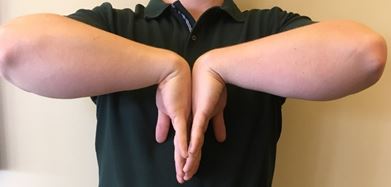Carpal Tunnel Syndrome (CTS) is a common diagnosis that plagues millions of hands every year. It falls under a class of diagnoses referred to as repetitive stress injuries which are injuries brought on or made worse by repetitive activities. Some of these activities include writing, typing, and manipulating tools and/or machinery.
How do you know if you have CTS?
CTS symptoms typically include: numbness and tingling in the hands and/or fingers, decreased sensation in the hand, pain in the wrist, hand or fingers and weakness with grip often noticed with things like difficulty holding a cup of coffee.
Test yourself!
Bring both of your hands directly in front of your chest. Press the backs of your hands together with fingers pointing downwards as shown below. Wait for 30-60 seconds or until numbness occurs or worsens. Once you feel the numbness, you should stop. If this occurs, it is likely you are experiencing inflammation at the carpal tunnel, which indicates you may have carpal tunnel syndrome.

What should you do if you think you have CTS?
The first thing you should do is get assessed by a professional. Even if your symptoms don’t interfere with your day to day life, it’s recommended to meet with a healthcare provider who will teach you how to keep your symptoms from getting worse and identify potential warning signs to be aware of. Through a course of differential diagnosing, your therapist will help you identify if what you’re experiencing is CTS, or your signs and symptoms are indicative of a different diagnosis. This differentiation is critical as several diagnoses have overlapping signs and symptoms.
In addition to proper assessment, your therapist will be able to help you:
- Decrease inflammation of your nerve
- Improve tissue integrity surrounding the carpus and decrease pain
- Educate you on techniques to help avoid future episodes of numbness
- Fit braces and other supportive devices, if necessary
- Teach stretches and exercises to prevent further worsening of symptoms
- Provide job/task modification options
Activities to limit if you think you may suffer from CTS:
- Typing (keying and mousing)
- Writing
- Twisting at the wrist (using a screwdriver or other such tools)
- Applying pressure on a hard surface at the wrist (leaning on your hands on a table top or counter or using your palm as a base to hammer objects)
- Cycling (wrists bent in that position while supporting weight)
- Typing at a keyboard while wrists rest on a hard desk surface
Things to help relieve carpal tunnel discomfort:
- Eliminate repetitive or weight bearing activities that are isolated at the base of the palm
- Take frequent breaks throughout the day to rest your hands in a relaxed position (resting your hands on top of your thighs in a seated position for 15 minutes every 1-2 hours is ideal)
- Apply ice to the bottom of your wrists to help decrease the inflammation
If you are currently experiencing chronic or occasional numbness in your hands, there are options for you to have relief! Let us help you address the issue with your tissue!

